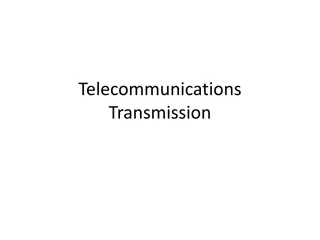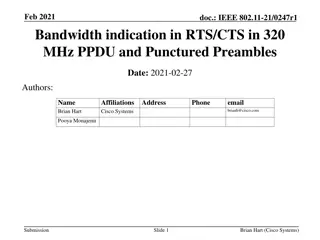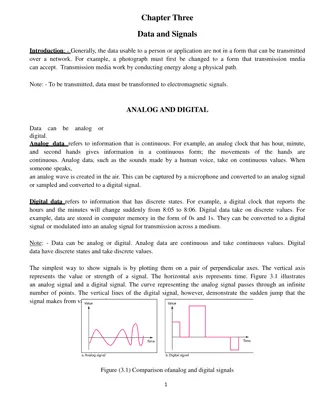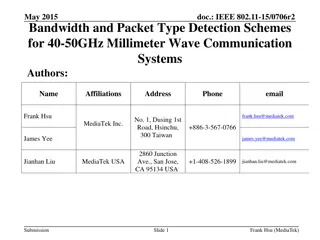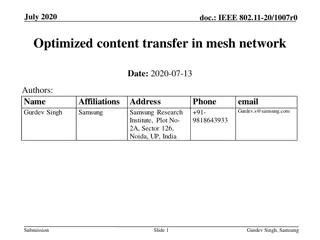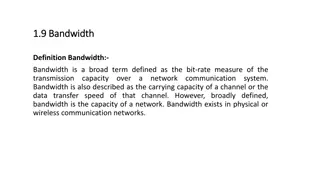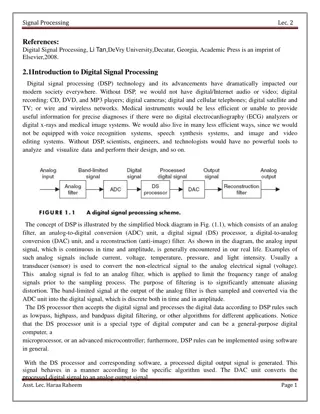Understanding Bandwidth and Digital Signals in Computer Networks
Exploring the concept of bandwidth in computer networks, which refers to the range of frequencies in a signal, and delving into the decomposition of signals into simple sine waves using tools. Additionally, the discussion covers digital signals, their representation, and the transmission of information in digital form.
Download Presentation

Please find below an Image/Link to download the presentation.
The content on the website is provided AS IS for your information and personal use only. It may not be sold, licensed, or shared on other websites without obtaining consent from the author. Download presentation by click this link. If you encounter any issues during the download, it is possible that the publisher has removed the file from their server.
E N D
Presentation Transcript
Computer Networks By Sadiq Shah Lecture 8 (Chapter 3) FATA University
Bandwidth The range of frequencies contained in a composite signal is its bandwidth. composite signal is a combination of simple sine waves with different frequencies, amplitudes, and phases.
Bandwidth-2 It is very difficult to manually decompose this signal into a series of simple sine waves. However, there are tools, both hardware and software, that can help us do the job. Figure 3.11 shows the result of decomposing the above signal in both the time and frequency domains.
Bandwidth-3 Example The bandwidth is normally a difference between two numbers. 10-5=5 For example, if a composite signal contains frequencies between 1000 and 5000, its bandwidth is 5000 1000, or 4000. Example 3.10 If a periodic signal is decomposed into five sine waves with frequencies of 100, 300, 500, 700, and 900 Hz, what is its bandwidth? Draw the spectrum, assuming all components have a maximum amplitude of 10 V. Solution Let fh be the highest frequency, fl the lowest frequency, and B the bandwidth. Then
Bandwidth Example Example 3.11 A periodic signal has a bandwidth of 20 Hz. The highest frequency is 60 Hz. What is the lowest frequency? Draw the spectrum if the signal contains all frequencies of the same amplitude. Solution Let fhbe the highest frequency, flthe lowest frequency, and B the bandwidth. Then The spectrum contains all integer frequencies. We show this by a series of spikes
DIGITAL SIGNALS In addition to being represented by an analog signal, information can also be represented by a digital signal. For example, a 1 can be encoded as a positive voltage and a 0 as zero voltage. A digital signal can have more than two levels. In this case, we can send more than 1 bit for each level. Figure 3.17 shows two signals, one with two levels and the other with four. In general, if a signal has L levels, each level needs log2L bits. For this reason, we can send log24 = 2 bits in part b.
DIGITAL SIGNALS 10110001 11 10 01 01 00 .
Example 3.16 A digital signal has eight levels. How many bits are needed per level? We calculate the number of bits from the following formula. Each signal level is represented by 3 bits.
Bit Rate The bit rate is the number of bits sent in 1s, expressed in bits per second (bps). bit rate (instead of frequency) is used to describe digital signals. What is the bit rate in this figure? Bitrate: 8bits/sec
Bitrate example Example 3.18 Assume we need to download text documents at the rate of 100 pages per second. What is the required bit rate of the channel? Solution A page is an average of 24 lines with 80 characters in each line. If we assume that one character requires 8 bits, the bit rate is
Bitrate Example Example 3.20 What is the bit rate for high-definition TV (HDTV)? Solution HDTV uses digital signals to broadcast high quality video signals. The HDTV screen is normally a ratio of 16 : 9 (in contrast to 4 : 3 for regular TV), which means the screen is wider. There are 1920 by 1080 pixels per screen, and the screen is renewed 30 times per second. Twenty-four bits represents one color pixel. We can calculate the bit rate as



